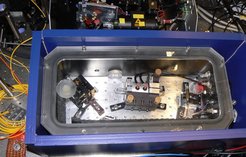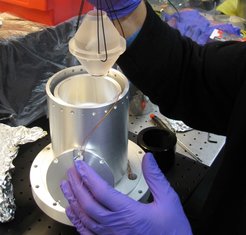Laser development
Following the fact that a recorded spectral line is the convolution of the line shape associated with the atomic sample with the laser line it is absolutely necessary to have a very narrow band spectroscopy laser. In this case the contribution from the laser system can be neglected allowing to draw conclusions about the atomic sample from the line shape. Also, the laser frequency has to be stable - or at least predictable - for the time needed to record one spectral line. In our experiment this is on the order of hundred seconds.
For decades gas laser pumped dye lasers have served as the working horse in precision spectroscopy. However, with the recent development of new laser diodes along with powerful, low-noise tapered amplifiers (TA) diode laser systems take over. They are easier to operate, more compact, and consume less power. Figure 1 shows a picture of the extended cavity diode laser used for hydrogen spectroscopy in our lab.
The laser diode runs at 972nm and is amplified in a TA to ~700mW. The light's frequency is doubled coherently (second harmonic generation (SHG)) in a KnBO3 crystal sitting in a power build-up cavity. In a second SHG stage a BBO crystal is used to convert the 486nm radiation to 243nm light which can be used to drive the two photon 1S-2S transition?.

Reference Cavity
To stabilize a laser one needs to compare its frequency to a stable reference. It turns out that the distance {$L$} between two ultra-high reflectivity mirrors can be mechanically stabilized to such an extend that for a few seconds
{$\frac{\Delta L}{L} < 10^{-15}$}.
These well spaced mirrors form an ultra-stable high finesse cavity. Several tricks have to be applied to reach this mechanical stability. First, the cavity is placed in a vacuum chamber to shield it from the environment (Figure 2). The cavity is oriented vertically and mounted on its mid-plane so that vertical accelerations stretch the upper part in the same way the lower part is compressed or vice versa. Then, the cavity sits on an active vibration isolation platform sitting on a heavy optical table.
To reduce length changes associated with thermal fluctuations the cavity spacer is made from ultra-low expansion glass (ULE). We stabilize the cavity's temperature at the point at which the ULE's thermal expansion coefficient is minimal. This suppresses the sensitivity to temperature fluctuations twofold: We use a material which is, to high extend, insensitive to temperature fluctuations and we then stabilize its surrounding temperature.

Further reading:

